window Citroen JUMPY 2011 2.G Owner's Manual
[x] Cancel search | Manufacturer: CITROEN, Model Year: 2011, Model line: JUMPY, Model: Citroen JUMPY 2011 2.GPages: 260, PDF Size: 9.5 MB
Page 2 of 260
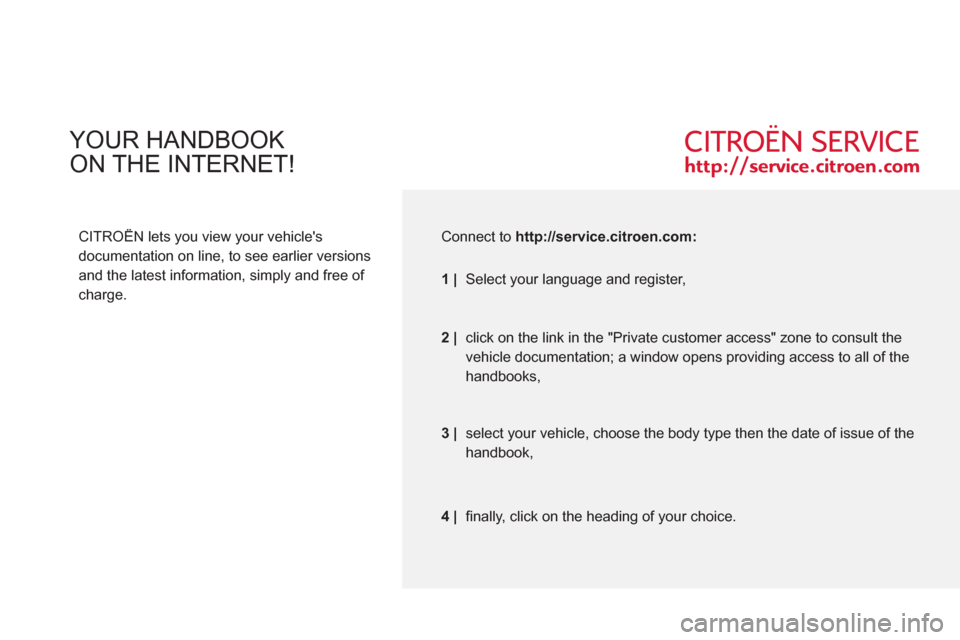
YOUR HANDBOOK
ON THE INTERNET!
CITROËN lets you view your vehicle's
documentation on line, to see earlier versions
and the latest information, simply and free of
charge.
Connect to http://service.citroen.com :
1|
Select your language and register,
click on the link in the "Private customer access" zone to consult the
vehicle documentation; a window opens providing access to all of the
handbooks,
select your vehicle, choose the body type then the date of issue of the
handbook,
fi nally, click on the heading of your choice.
2|
3 |
4 |
Page 4 of 260
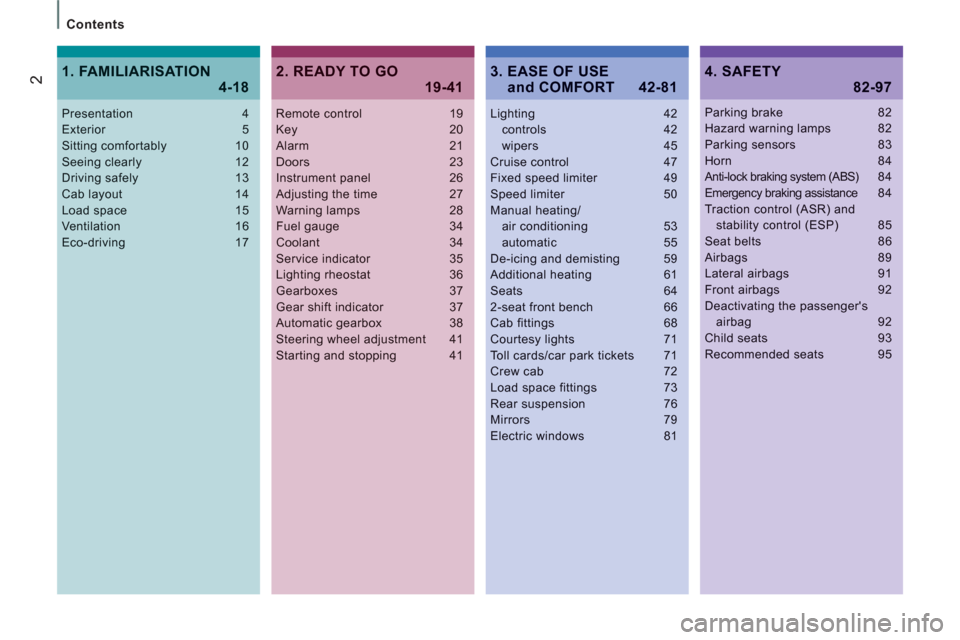
2
Contents
Remote control 19Key 20Alarm 21Doors 23Instrument panel 26Adjusting the time 27Warning lamps 28Fuel gauge 34Coolant 34Service indicator 35Lighting rheostat 36Gearboxes 37Gear shift indicator 37Automatic gearbox 38Steering wheel adjustment 41Starting and stopping 41
Lighting 42controls 42wipers 45Cruise control 47Fixed speed limiter 49Speed limiter 50Manual heating/air conditioning 53automatic 55De-icing and demisting 59Additional heating 61Seats 642-seat front bench 66Cab fittings 68Courtesy lights 71Toll cards/car park tickets 71Crew cab 72Load space fittings 73Rear suspension 76Mirrors 79
Electric windows 81
2. READY TO GO
19-41
4. SAFETY
82-97
Presentation 4Exterior 5Sitting comfortably 10Seeing clearly 12Driving safely 13Cab layout 14Load space 15Ventilation 16Eco-driving 17
1. FAMILIARISATION
4-18
Parking brake 82Hazard warning lamps 82Parking sensors 83Horn 84Anti-lock braking system (ABS) 84Emergency braking assistance84Traction control (ASR) andstability control (ESP) 85Seat belts 86Airbags 89Lateral airbags 91Front airbags 92Deactivating the passenger'sairbag 92Child seats 93Recommended seats 95
3. EASE OF USE and COMFORT 42-81
Page 13 of 260
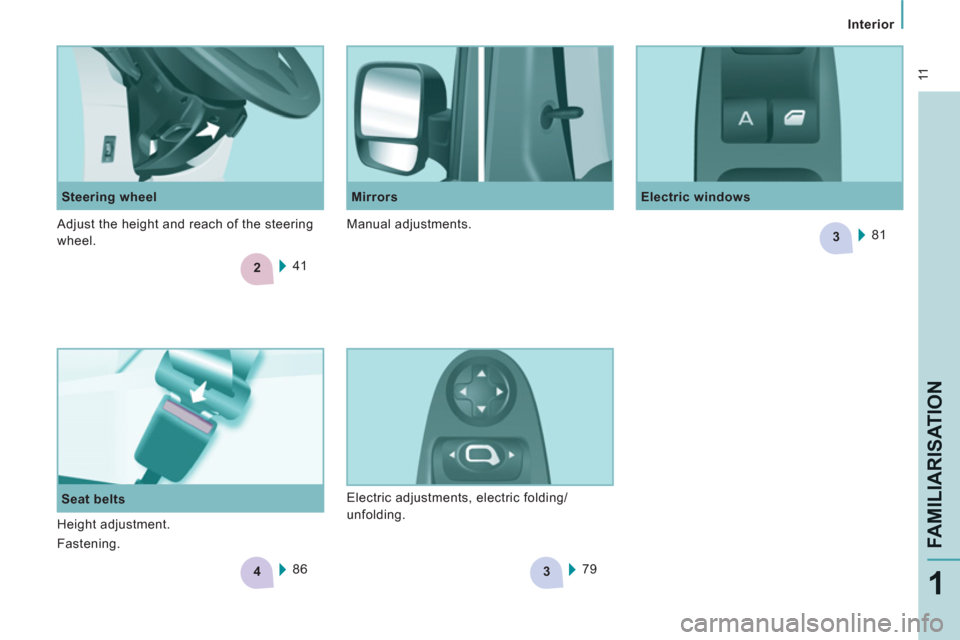
2
4
3
3
11
Interior
FAMILIARISATIO
N
1
Seat belts
Steering wheel
Electric windows
Mirrors
41
86 81
79 Electric adjustments, electric folding/
unfolding.
Height adjustment.
Fastening. Adjust the height and reach of the steering
wheel. Manual adjustments.
Page 19 of 260
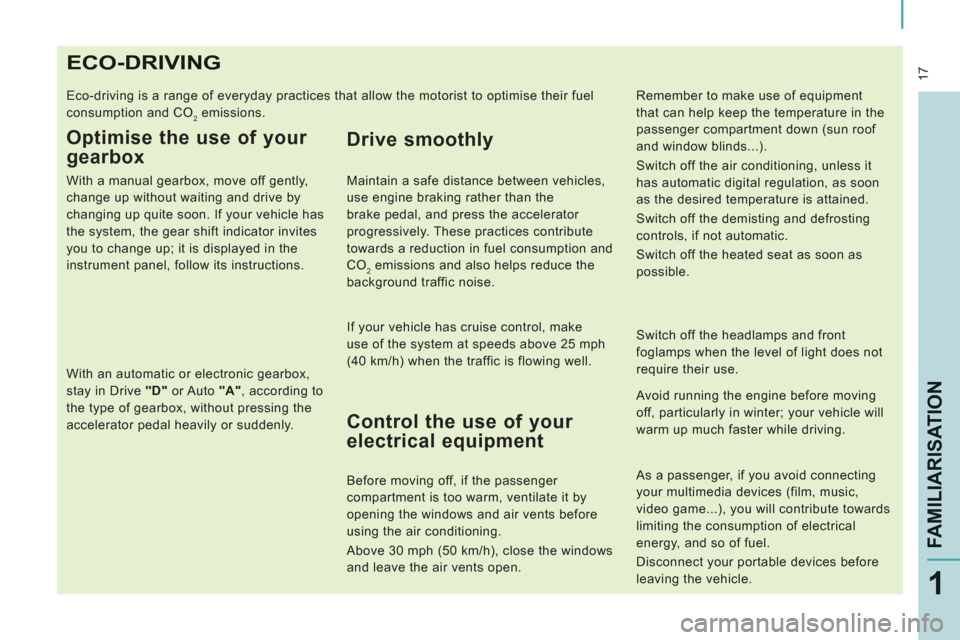
17
FAMILIARISATIO
N
1
ECO-DRIVING
Eco-driving is a range of everyday practices that allow the motorist to optimise their fuel
consumption and CO
2 emissions.
Optimise the use of your
gearbox
With a manual gearbox, move off gently,
change up without waiting and drive by
changing up quite soon. If your vehicle has
the system, the gear shift indicator invites
you to change up; it is displayed in the
instrument panel, follow its instructions.
With an automatic or electronic gearbox,
stay in Drive "D"
or Auto "A"
, according to
the type of gearbox, without pressing the
accelerator pedal heavily or suddenly.
Control the use of your
electrical equipment
Before moving off, if the passenger
compartment is too warm, ventilate it by
opening the windows and air vents before
using the air conditioning.
Above 30 mph (50 km/h), close the windows
and leave the air vents open.
Switch off the headlamps and front
foglamps when the level of light does not
require their use.
Avoid running the engine before moving
off, particularly in winter; your vehicle will
warm up much faster while driving.
Drive smoothly
Maintain a safe distance between vehicles,
use engine braking rather than the
brake pedal, and press the accelerator
progressively. These practices contribute
towards a reduction in fuel consumption and
CO
2 emissions and also helps reduce the
background traffic noise.
If your vehicle has cruise control, make
use of the system at speeds above 25 mph
(40 km/h) when the traffic is flowing well.
As a passenger, if you avoid connecting
your multimedia devices (film, music,
video game...), you will contribute towards
limiting the consumption of electrical
energy, and so of fuel.
Disconnect your portable devices before
leaving the vehicle.
Remember to make use of equipment
that can help keep the temperature in the
passenger compartment down (sun roof
and window blinds...).
Switch off the air conditioning, unless it
has automatic digital regulation, as soon
as the desired temperature is attained.
Switch off the demisting and defrosting
controls, if not automatic.
Switch off the heated seat as soon as
possible.
Page 23 of 260
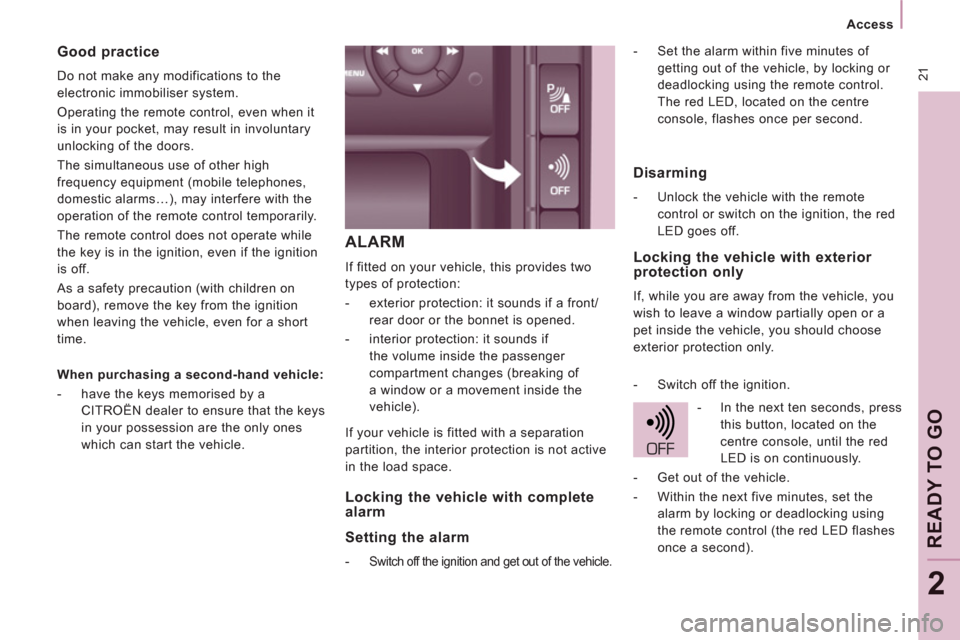
21
Access
READY TO GO
2
ALARM
If fitted on your vehicle, this provides two
types of protection:
- exterior protection: it sounds if a front/
rear door or the bonnet is opened.
- interior protection: it sounds if
the volume inside the passenger
compartment changes (breaking of
a window or a movement inside the
vehicle).
Good practice
Do not make any modifications to the
electronic immobiliser system.
Operating the remote control, even when it
is in your pocket, may result in involuntary
unlocking of the doors.
The simultaneous use of other high
frequency equipment (mobile telephones,
domestic alarms…), may interfere with the
operation of the remote control temporarily.
The remote control does not operate while
the key is in the ignition, even if the ignition
is off.
As a safety precaution (with children on
board), remove the key from the ignition
when leaving the vehicle, even for a short
time.
If your vehicle is fitted with a separation
partition, the interior protection is not active
in the load space.
Locking the vehicle with complete
alarm
Setting the alarm
- Switch off the ignition and get out of the vehicle.
When purchasing a second-hand vehicle:
- have the keys memorised by a
CITROËN dealer to ensure that the keys
in your possession are the only ones
which can start the vehicle.
- Set the alarm within five minutes of
getting out of the vehicle, by locking or
deadlocking using the remote control.
The red LED, located on the centre
console, flashes once per second.
Disarming
- Unlock the vehicle with the remote
control or switch on the ignition, the red
LED goes off.
Locking the vehicle with exterior
protection only
If, while you are away from the vehicle, you
wish to leave a window partially open or a
pet inside the vehicle, you should choose
exterior protection only.
- Switch off the ignition.
- In the next ten seconds, press
this button, located on the
centre console, until the red
LED is on continuously.
- Get out of the vehicle.
- Within the next five minutes, set the
alarm by locking or deadlocking using
the remote control (the red LED flashes
once a second).
Page 60 of 260

58
Ventilation
CORRECT USE OF THE VENTILATION AND AIR
CONDITIONING
Passenger compartment filter,
carbon filter
Ensure that this filter is in good condition
and have all of the filter elements replaced
regularly.
Vents
"Leave them open"
For optimum distribution and diffusion of hot
or cool air in the passenger compartment,
there are adjustable central and side vents
which can be directed sideways (right or
left) towards the top of the body. For your
comfort while driving, do not close them,
direct the flow of air towards the windows
instead.
The air vents directed towards the floor of
the vehicle complete the equipment.
Refer to the "Checks" section of
chapter 6.
Air conditioning
In all seasons, the air conditioning should
only be used with the windows closed.
However, if the interior temperature remains
high after a prolonged period parked in
the sun, do not hesitate to ventilate the
passenger compartment for a few minutes. Use the AUTO mode as much as
possible as it permits optimised control
of all of the functions: air flow, passenger
compartment comfort temperature,
air distribution, air intake mode or air
recirculation in the passenger compartment.
Operate the air conditioning system for 5 to
10 minutes, once or twice a month, to keep
it in perfect working order.
It is normal that the condensation created by
the air conditioning system results in a flow
of water which may form a puddle under the
vehicle when parked.
If the system does not produce cold air, do
not use it and contact a CITROËN dealer or
a qualified workshop.
Page 62 of 260

60
Ventilation
De-icing the rear screen and/
or mirrors
Pressing this button, with the engine
running, activates the rapid demisting -
de-icing of the rear screen and/or electric
mirrors.
This function switches off:
- when the button is pressed,
- when the engine is switched off,
- automatically to prevent excessive
energy consumption.
Automatic air conditioning: visibility
programme
The comfort programme (AUTO) may not
be sufficient to quickly demist or de-ice the
windows (humidity, several passengers, ice).
In this case, select the visibility programme.
The visibility programme indicator light
comes on.
It activates the air conditioning, the air flow,
the de-icing of the rear screen and provides
optimum distribution of the ventilation to the
windscreen and side windows.
It deactivates the air recirculation.
Page 74 of 260
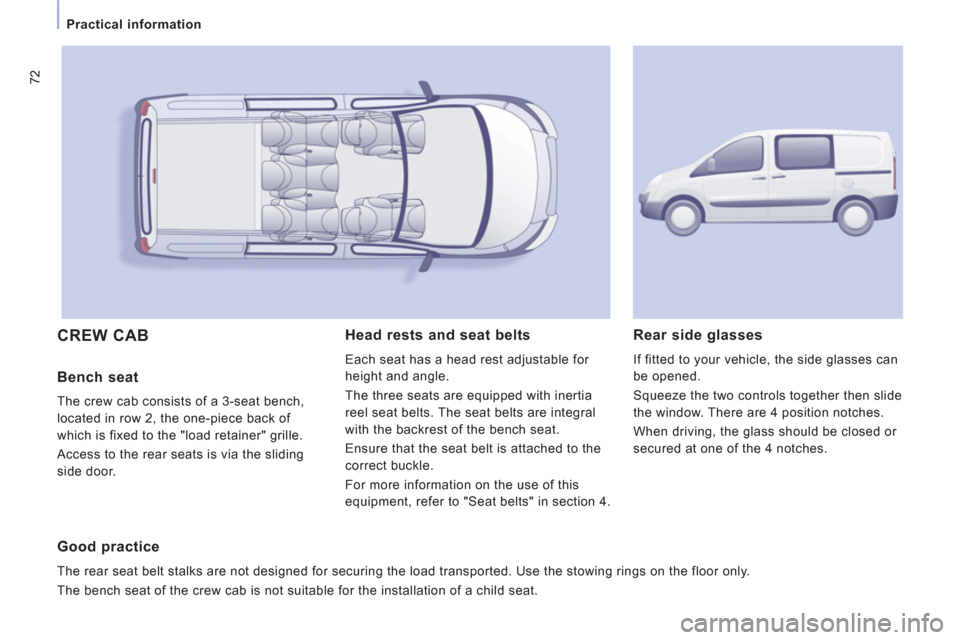
72
Practical information
CREW CAB
Bench seat
The crew cab consists of a 3-seat bench,
located in row 2, the one-piece back of
which is fixed to the "load retainer" grille.
Access to the rear seats is via the sliding
side door.
Head rests and seat belts
Each seat has a head rest adjustable for
height and angle.
The three seats are equipped with inertia
reel seat belts. The seat belts are integral
with the backrest of the bench seat.
Ensure that the seat belt is attached to the
correct buckle.
For more information on the use of this
equipment, refer to "Seat belts" in section 4.
Good practice
The rear seat belt stalks are not designed for securing the load transported. Use the stowing rings on the floor only.
The bench seat of the crew cab is not suitable for the installation of a child seat.
Rear side glasses
If fitted to your vehicle, the side glasses can
be opened.
Squeeze the two controls together then slide
the window. There are 4 position notches.
When driving, the glass should be closed or
secured at one of the 4 notches.
Page 81 of 260

79
Mirrors and windows
EASE OF USE
and
COMFOR
T
3
MIRRORS MIRRORS AND WINDOWS
Electric folding/unfolding
If your vehicle is fitted with this function, the
mirrors can be folded or unfolded electrically
from the inside, with the vehicle parked and
the ignition on:
- Place switch A
in the centre position.
- Pull switch A
rearwards.
Manual exterior mirrors
Move the lever in all four directions to
adjust.
When the vehicle is parked, the exterior
mirrors can be folded back manually.
The mirror is spherical to broaden the field
of side vision. Objects observed are, in
reality, closer than they appear. Therefore,
take this into account in order to judge the
distance correctly.
Heated mirrors
If your vehicle is fitted with this function,
press the rear screen demisting button.
If the mirror casing has come out of its
initial location, with the vehicle stationary,
reposition the mirror casing manually or use
the electric folding switch.
There is no risk of breakage even in the
presence of ice.
Electric exterior mirrors
- Move switch A
to the right or to the left
to select the corresponding mirror.
- Move knob B
in all four directions to
adjust.
- Return switch A
to the centre position.
Page 82 of 260
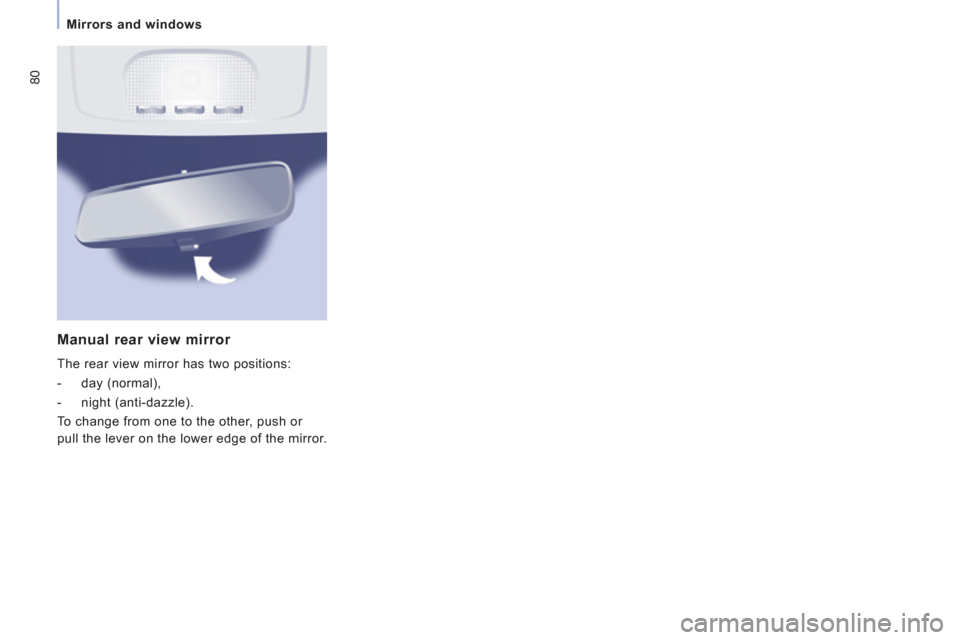
80
Mirrors and windows
Manual rear view mirror
The rear view mirror has two positions:
- day (normal),
- night (anti-dazzle).
To change from one to the other, push or
pull the lever on the lower edge of the mirror.